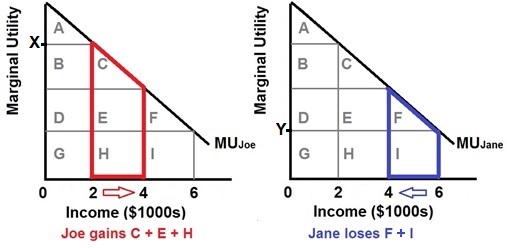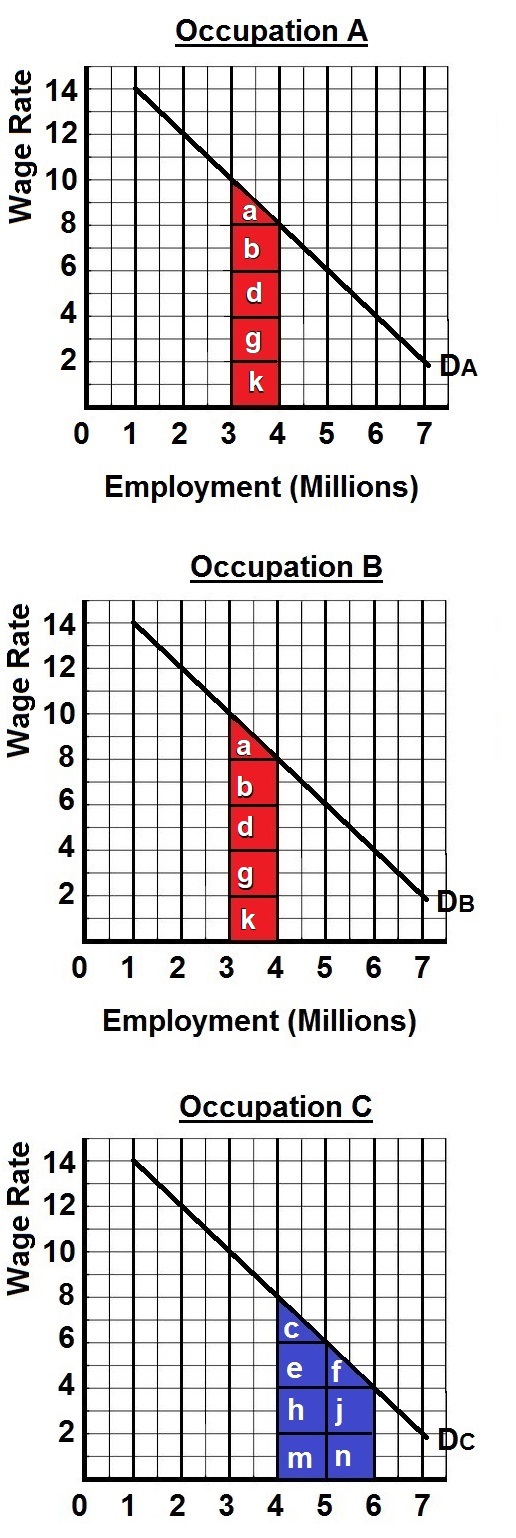|
MODEL - The Case
for Equality = The President Trump Example of the
5Es
The Utility Maximizing Distribution
of Income

Assumptions:
- assume that the money
incomes of two individuals, Joe and Jane, are subject to
diminishing marginal utility.
- In any time period, income
receivers spend the first dollars received on the
products they value most, products whose marginal utility
is high.
- The identical
diminishing-marginal-utility-from-income curves (MUjoe
and MUjane in the figure) reflect the assumption that Joe
and Jane have the same capacity to derive utility from
income.
- income is initially unequally
distributed ($2000 to Joe and $6000 to Jane), therefore,
the marginal utility derived from the last dollar will be
greater for Joe (X ) than for Jane (Y).
Conclusions:
- The basic argument for
an equal distribution of income is that income equality
maximizes total consumer satisfaction (utility) from any
particular level of output and income.
- If a single dollar of income is
shifted from Jane to Joe, that is, toward greater
equality, then Joe's utility increases by X and Jane's
utility decreases by Y. The combined utility then
increases by X minus Y (Joe's large gain minus Jane's
small loss).
- The area under the MU curve and
to the left of the individual's particular level of
income represents the total utility of that income.
Therefore, as a result of the transfer of the $2000, Joe
has gained utility represented by the red area below
curve MUjoe (area C + E + H), and Jane has lost utility
represented by the blue area below curve MUjane (area F +
I).
- The red area is obviously
greater than the blue area, so if the income distribution
is initially unequal, then distributing income more
equally can increase the combined utility of the two
individuals.
Criticisms: Incentives and Efficiency
(The Equality-Efficiency Trade-off)
- Although the logic of
the argument for equality is sound, critics attack its
fundamental assumption that there is some fixed amount of
output produced and therefore a fixed amount of income to
be distributed.
- Critics of income equality argue
that the way in which income is distributed is an
important determinant of the amount of output, or income,
that is produced and is available for distribution. A
more equal distribution of income may be a disincentive
to work and cause the total amount of income to decrease.
This is the Equality-Efficiency trade-off.
MODEL - The
Occupational Segregation Model of
Discrimination

Assumptions:
- the labor force is
comprised of 6 million men and 6 million women
workers
- the economy has 3 occupations,
A, B, and C, each having identical demand curves for
labor
- men and women workers are
homogeneous with respect to their labor-market
capabilities
- women are discriminated against
by being excluded from occupations A and B and are
confined to C
- except for discrimination, the
economy is competitive, therefore Dlabor = MRP = P x
MP.
- There are no barriers to
mobility between the occupations for men.
Conclusions:
- Men would distribute
themselves equally in occupations A and B (3 million in
each) and earn high wages, $10
- All 6 million women will be
crowded into occupation C and earn low wages,
$4
- The result of discrimination is
a loss of output for society (less is being produced with
the same number of workers)
* Remember that labor
demand reflects labor's marginal revenue product (MRP
= P x MP), which is labor's contribution to domestic
output.
* Thus, the red areas for
occupations A and B (a + b + d + g + k in each
occupation) in the figure above show the decrease in
domestic output (MP x P) caused by subtracting 1
million women from each of these occupations.
* Similarly, the blue area for
occupation C (c + e + h+ m + f + j + n) shows the
increase in domestic output caused by moving 2 million
women into occupation C.
* Although society would gain
the added output represented by the blue area in
occupation C, it would lose the output represented by
the sum of the red areas in occupations A and B. That
output loss exceeds the output gain, producing a net
output loss for society caused by
discrimination.
- If discrimination disappears,
women, attracted by higher wage rates, shift from
occupation C to A and B
* 1 million women move
into A and another 1 million move into B.
* Ending discrimination clearly
benefits women, who now receive higher wages; it hurts
men, who now receive lower wages.
* Society gains. The
elimination of occupational segregation reverses the
net output loss discussed above. Society gains the
output represented by the two red areas in occupations
A and B and loses the output represented by the blue
area in occupation C. When discrimination is ended
society gains more than it loses.
|